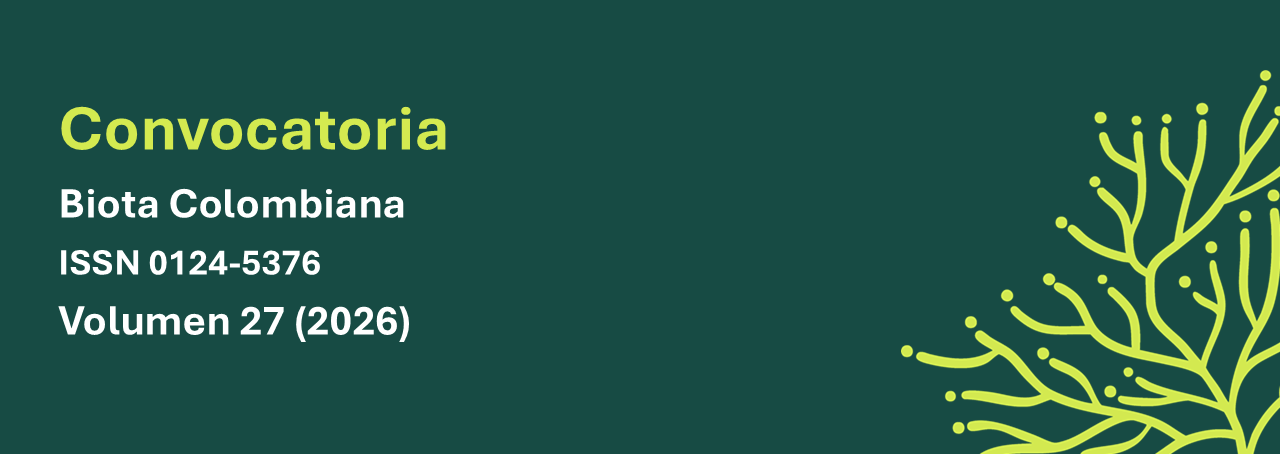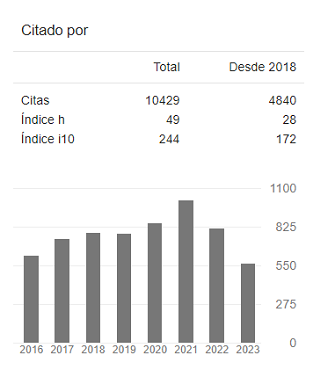Resumen (es):
La especie Heterophrynus boterorum es endémica de Colombia, fue descrita en 2013 y han sido registrados pocos especímenes. Presenta variación morfológica, la cual podría asociarse con las condiciones ambientales, o a procesos de aislamiento. Se modeló la distribución potencial de la especie usando MaxEnt, para conocer otras posibles localidades de ocurrencia y la influencia de las variables ambientales que pueden condicionar su presencia. Adicionalmente, se contrastó la distribución potencial con el Sistema de Áreas Protegidas en Colombia. La especie presenta una distribución potencial hacia la región central de los Andes, sobre las Cordilleras Central y Occidental. La precipitación y la temperatura, en especial durante la temporada más seca, fueron las variables más influyentes en el modelo, lo cual es coherente con los requerimientos de humedad y estabilidad climática en Amblypygi. Solo una de las poblaciones conocidas está registrada dentro de un área protegida, por tanto, es necesario diseñar mejores estrategias de conservación para preservar a H. boterorum.
Resumen (en):
The species Heterophrynus boterorum is endemic to Colombia, and was described in 2013 with just a few specimens. It has morphological variation that may be correlated with environmental conditions, or with isolation processes. We modeled the potential distribution of this species using software Maxent in order to know of other possible occurrence localities and the influence of environmental variables which can condition its presence. Additionally, we contrasted the potential distribution with the National System of Protected Areas of Colombia. The species has a potential distribution in the central region of the Andes in the Cordillera Central and Occidental, which connects all known populations. Precipitation and temperature, especially during the driest season, were the most influential variables in the model, which is coherent regarding the requirements for humidity and climatic stability in Amblypygi. Only one of the known populations is recorded in a protected area, so it is necessary to design better conservation strategies to preserve H. boterorum.
Palabras clave:
Arachnida, Biogeografía, Conservación, Distribución potencial (es)
Referencias
Anderson, R. P. (2012). Harnessing the world’s biodiversity data: Promise and peril in ecological niche modeling of species distributions. Annals of the New York Academy of Sciences, 1260(1), 66–80. https://doi.org/10.1111/j.1749-6632.2011.06440.x
Anderson, R. P. (2013). A framework for using niche models to estimate impacts of climate change on species distributions. Annals of the New York Academy of Sciences, 1297(1), 8–28. https://doi.org/10.1111/nyas.12264
Anderson, R. P., & Gonzalez, I. (2011). Species-specific tuning increases robustness to sampling bias in models of species distributions: An implementation with Maxent. Ecological Modelling, 222(15), 2796–2811. https://doi.org/10.1016/j.ecolmodel.2011.04.011
Barba Hernandez, J. A., Contreras-Martínez, S., Alcantara Concepcion, P. C., & Cárdenas Hernández, O. (2017). Comparación de cuatro algoritmos para modelar la distribución de especies de aves en la Sierra de Manantlán. https://doi.org/10.13140/RG.2.2.21754.39366
Booth, T. H., Nix, H. A., Busby, J. R., & Hutchinson, M. F. (2014). bioclim: The first species distribution modelling package, its early applications and relevance to most current MaxEnt studies. Diversity and Distributions, 20(1), 1–9. https://doi.org/10.1111/ddi.12144
Bürgl, H. (2017). Historia geológica de Colombia | Revista de la Academia Colombiana de Ciencias Exactas, Físicas y Naturales. Revista de la Academia Colombiana de Ciencias Exactas, Físicas y Naturales, 41(1), 391–449. https://doi.org/10.18257/raccefyn.581
Camacho, J. H., Guerra, A. H., Quijano, R. O., & Walschburger, T. (1992). Centros de endemismo en Colombia. Volumen Especial. Mexico: Acta Zoologica Mexicana, Volumen especial.
Chapin, K. J., Winkler, D. E., Wiencek, P., & Agnarsson, I. (2018). Island biogeography and ecological modeling of the amblypygid Phrynus marginemaculatus in the Florida Keys archipelago. Ecology and Evolution, 8(18), 9139–9151. https://doi.org/10.1002/ece3.4333
Chirivi-Joya, D., Moreno-Gonzalez, J. A., & Fagua, G. (2020). Two new species of the whip-spider genus Heterophrynus (Arachnida: Amblypygi) with complementary information of four species. Zootaxa, 4803(1), 001–041. https://doi.org/10.11646/zootaxa.4803.1.1
Churchill, S. P. (1995). Biodiversity and conservation of neotropical montane forests. Neotropical Montane Forest Biodiversity and Conservation Symposium, New York Botanical Garden (USA), 1993.
Drew, C. A., Wiersma, Y. F., & Huettmann, F. (2010). Predictive species and habitat modeling in landscape ecology: Concepts and applications. Springer Science & Business Media.
Elith, J., Kearney, M., & Phillips, S. (2010). The art of modelling range-shifting species. Methods in Ecology and Evolution, 1(4), 330–342. https://doi.org/10.1111/j.2041-210X.2010.00036.x
Elith, J., Phillips, S. J., Hastie, T., Dudík, M., Chee, Y. E., & Yates, C. J. (2011). A statistical explanation of MaxEnt for ecologists. Diversity and Distributions, 17(1), 43–57. https://doi.org/10.1111/j.1472-4642.2010.00725.x
Elmore, K. L., Weiss, S. J., & Banacos, P. C. (2003). Operational ensemble cloud model forecasts: Some preliminary results. Weather and Forecasting, 18(5), 953–964. https://doi.org/10.1175/1520-0434(2003)018<0953:OECMFS>2.0.CO;2
Fielding, A. H., & Bell, J. F. (1997). A review of methods for the assessment of prediction errors in conservation presence/absence models. Environmental Conservation, 24(1), 38–49. https://doi.org/10.1017/S0376892997000088
Gentry, A. H. (1982). Neotropical floristic diversity: Phytogeographical connections between Central and South America, Pleistocene climatic fluctuations, or an accident of the Andean orogeny? Annals of the Missouri Botanical Garden, 69(3), 557–593. https://doi.org/10.2307/2399084
Giupponi, A. P., & Kury, A. B. (2013). Two new species of Heterophrynus Pocock, 1894 from Colombia with distribution notes and a new synonymy (Arachnida: Amblypygi: Phrynidae). Zootaxa, 3647(2), 329–342. https://doi.org/10.11646/zootaxa.3647.2.5
Gómez, A. C., Consuegra, N. P., & Ochoa, F. L. (2015). Levantamiento de la Cordillera Oriental de los Andes colombianos. Hipótesis: Apuntes Científicos Uniandinos, 19, 66–73.
Guisan, A., & Zimmermann, N. E. (2000). Predictive habitat distribution models in ecology. Ecological Modelling, 135(2–3), 147–186. https://doi.org/10.1016/S0304-3800(00)00354-9
Harvey, M. S. (2003). Catalogue of the smaller arachnid orders of the world: Amblypygi, Uropygi, Schizomida, Palpigradi, Ricinulei and Solifugae. Csiro Publishing.
Hawkins, B. A., Porter, E. E., & Felizola Diniz-Filho, J. A. (2003). Productivity and History as Predictors of the Latitudinal Diversity Gradient of Terrestrial Birds. Ecology, 84(6), 1608–1623. https://doi.org/10.1890/0012-9658(2003)084[1608:PAHAPO]2.0.CO;2
Hijmans, R. J., Cameron, S. E., Parra, J. L., Jones, P. G., & Jarvis, A. (2005). Very high resolution interpolated climate surfaces for global land areas. International Journal of Climatology: A Journal of the Royal Meteorological Society, 25(15), 1965–1978. https://doi.org/10.1002/joc.1276
Joya, D. C., & de Armas, L. F. (2012). La subfamilia Phryninae (Amblypygi: Phrynidae) en Colombia. Boletin de La SEA, 50, 395–402.
McBride, J. L., & Ebert, E. E. (2000). Verification of quantitative precipitation forecasts from operational numerical weather prediction models over Australia. Weather and Forecasting, 15(1), 103–121. https://doi.org/10.1175/1520-0434(2000)015<0103:VOQPFF>2.0.CO;2
Morrone, J. J. (2001). Biogeografía de América Latina y el Caribe. Volumen 3, Manuales y tesis de la Sociedad Entomológica Aragonesa. Zaragoza, España.
Morrone, J. J. (2017). Neotropical biogeography: Regionalization and evolution. CRC Press.
Naimi, B., & Araújo, M. B. (2016). sdm: A reproducible and extensible R platform for species distribution modelling. Ecography, 39(4), 368–375. https://doi.org/10.1111/ecog.01881
Peterson, A. T., Soberón, J., Pearson, R. G., Anderson, R. P., Martínez-Meyer, E., Nakamura, M., & Araújo, M. B. (2011). Ecological niches and geographic distributions (MPB-49). In Ecological Niches and Geographic Distributions (MPB-49). Princeton University Press.
Phillips, S. J., Anderson, R. P., & Schapire, R. E. (2006). Maximum entropy modeling of species geographic distributions. Ecological Modelling, 190(3–4), 231–259. https://doi.org/10.1016/j.ecolmodel.2005.03.026
Phillips, S. J., & Dudík, M. (2008). Modeling of species distributions with Maxent: New extensions and a comprehensive evaluation. Ecography, 31(2), 161–175. https://doi.org/10.1111/j.0906-7590.2008.5203.x
Phillips, S. J., Dudík, M., & Schapire, R. E. (2004). A maximum entropy approach to species distribution modeling. Proceedings of the Twenty-First International Conference on Machine Learning, 83.
Roa, T. V., Castro, J. D. C., Meluk, H. M., Trujillo, F., & Guerra, F. M. (2015). Caracterización ecológica de cuencas utilizadas por el delfín rosado Inia geoffrensis en Colombia, a través de modelamiento de nicho. Momentos de Ciencia, 12(2).
Saseendran, S. A., Singh, S. V., Rathore, L. S., & Das, S. (2002). Characterization of weekly cumulative rainfall forecasts over meteorological subdivisions of India using a GCM. Weather and Forecasting, 17(4), 832–844. https://doi.org/10.1175/1520-0434(2002)017<0832:COWCRF>2.0.CO;2
Shcheglovitova, M., & Anderson, R. P. (2013). Estimating optimal complexity for ecological niche models: A jackknife approach for species with small sample sizes. Ecological Modelling, 269, 9–17. https://doi.org/10.1016/j.ecolmodel.2013.08.011
Swets, J. A. (2014). Signal detection theory and ROC analysis in psychology and diagnostics: Collected papers. Psychology Press.
Varela, S., Mateo, R. G., García-Valdés, R., & Fernández-González, F. (2014). Macroecología y ecoinformática: Sesgos, errores y predicciones en el modelado de distribuciones: Ecosistemas, 23(1), 46–53. https://doi.org/10.7818/ECOS.2014.23-1-07
Vásquez Palacios, S., Chiriví Joya, D. A., García Hernández, A. L., Mantilla-Meluk, H., & Torres Carrera, J. D. (2019). Morphological variation in Heterophrynus boterorum (Arachnida: Amblypygi: Phrynidae). Biota Colombiana, 20(2), 32–45. https://doi.org/10.1515/9781400840670
Veloz, S. D. (2009). Spatially autocorrelated sampling falsely inflates measures of accuracy for presence-only niche models. Journal of Biogeography, 36(12), 2290–2299. https://doi.org/10.1111/j.1365-2699.2009.02174.x
Weygoldt, P. (2000). Whip Spiders (Chelicerata: Amblypygi); Their Biology, Morphology and Systematics. Apollo Books. https://scholar.google.com/scholar?hl=es&as_sdt=0%2C5&q=Weygoldt%2C+P.+%282000%29.+Whip+Spiders+%28Chelicerata%3A+Amblypygi%29%3A+their+biology%2C+morphology+and+systematics.+Apollo+Books.&btnG=
Cómo citar

Esta obra está bajo una licencia internacional Creative Commons Atribución-NoComercial-SinDerivadas 4.0.
Derechos de autor 2023 Instituto de Investigación de Recursos Biológicos Alexander Von Humboldt


















